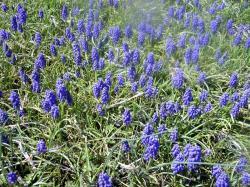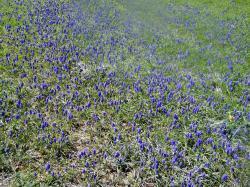I have lived in this house for almost 11 years now. Behind me is a big field that the land owners crops every year. These

flowers came up this year for only the second time since I have lived here. They no teil plant each year so the ground never gets turned over. This winter here in my part of Kentucky stayed pretty wet, So I figured out why this is only the second time they came up. We wanted to dig some of them up for our flower bed. They were about 10 inches deep in the ground

. They come from bulbs. If the winter is to dry then they can't come up, but this spring they were hoping. So pretty, a real dark blue. The whole area looked like water. I hope they come back next year. Can any one tell me what they are called. Thanks.
 flowers came up this year for only the second time since I have lived here. They no teil plant each year so the ground never gets turned over. This winter here in my part of Kentucky stayed pretty wet, So I figured out why this is only the second time they came up. We wanted to dig some of them up for our flower bed. They were about 10 inches deep in the ground
flowers came up this year for only the second time since I have lived here. They no teil plant each year so the ground never gets turned over. This winter here in my part of Kentucky stayed pretty wet, So I figured out why this is only the second time they came up. We wanted to dig some of them up for our flower bed. They were about 10 inches deep in the ground